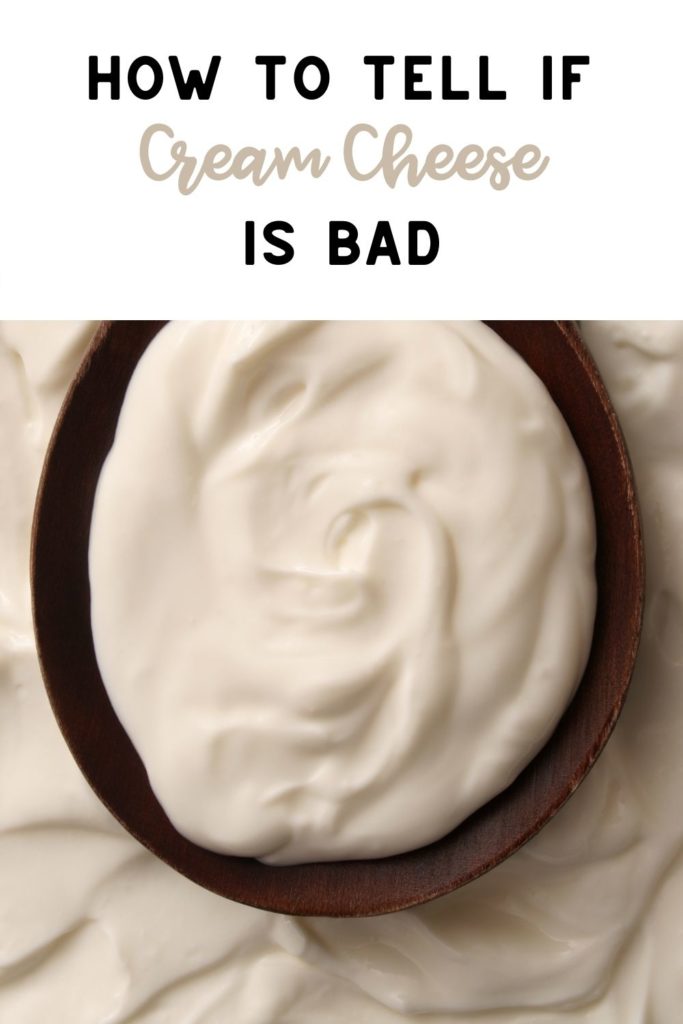Cream cheese is a popular breakfast product, particularly among youngsters. Most of the time, you’ll devour it because it’s so delicious, but it’s possible to locate a forgotten packet in the back of your fridge. In such a scenario, the main concern is whether cream cheese goes bad.
This product generally comprises preservatives that limit bacteria and mold development and prevent spoiling in most circumstances. Consequently, you can store unopened cream cheese in the fridge for up to a month or beyond the indicated expiration date.
This post may contain affiliate links. Read my disclosure policy here.
How Can I Tell If Cream Cheese Is Bad
Now that you know how long cream cheese may be left out for, how can you tell if it’s gone bad?
Unfortunately, even if you store your cream cheese properly, it will eventually go bad.
No matter the efforts you make, it is essential to identify the first indications of deterioration. You should be able to tell if your cream cheese is no longer edible.
That said, let’s look at some of the ways to tell if your cheese has gone bad;
- Liquid — If you see a dried-out cream cheese top with bigger liquid pools, the spoiling process has begun, and it is the best time to consume your cream cheese.
- Smell — The aroma of fresh cream cheese is pleasantly gentle and light, so if unpleasant, this is an indication that your cheese is spoiled.
- Taste — In most circumstances, cream cheese should taste good. If the scent is intact, you should examine the taste if the cheese has been in the fridge for more than a month or past the expiration date. Any unpleasant flavor will be an indication that it has gone bad, and it should be discarded.
- Colour — Fresh cream cheese is white or light creamy in hue. When a product becomes yellow with discolored blue or green areas, it is rotten.
- The texture should be discarded if cream cheese loses its spreadable texture and becomes dry, lumpy, cracked, or waxy when exposed to a wet surface. The same applies to bacteria or mold, which implies your cream cheese is no longer edible.
- Mold —Mold can be detected on obsolete cream cheese in some circumstances, suggesting that you should throw it immediately. Some of them create harmful chemicals to your health, so don’t put your health in danger.
- Looks— It’s easy to notice that your cream cheese has gone bad from the moment you have a glance at it. You should consider your cream cheese bad if there are some signs of mold. Additionally, a yellowish or greenish presence on your cream cheese could also be an indication that it has gone bad and, therefore, not safe for consumption.
- Consistency — If the top of a cream cheese container seems slimy or overly soft, it is an indication that molds or germs have penetrated the cream cheese, and you should discard it.
- It’s recommended that you refrigerate the cream cheese before the two-hour rule expires. Furthermore, it’s better to toss it out if it’s been more than two hours, regardless of how it looks or tastes.

How to Prolong Cream Cheese’s LifeSpan
If there’s one thing to remember, it’s that you should always discard spilled dream cheese. If you ingest it when it already feels or tastes expired, you can develop stomach poisoning as a result.
Fortunately, there are methods for extending the life of cream cheese and making it edible even after it has passed its expiration date. Below are some of the best approaches you can take:
- Temperature — You should not keep cream cheese at room temperature for more than two hours because germs multiply between 40 and 140 degrees Fahrenheit. As soon as you finish using it, place it in the fridge or cooler.
- Container —When keeping cream cheese in the fridge, use an airtight container or cover it with foil to prevent germs from entering.
- Freezer — If you want to extend the life of cream cheese even more, place it in the freezer. Wrap the cream cheese in foil, plastic freezer wrap, or a bag to prevent it from altering consistency, and store it away from other raw meat in the refrigerator.
- Use Utensils — When baking or spreading cream cheese on bread, use clean and dry utensils that the mouth has not touched or other food, especially raw meat.
How To Store Cream Cheese
Because of the similarities in ingredients and production procedures, storing cream cheese is similar to keeping cottage cheese. When you buy a container of cream cheese, put it in the refrigerator right away.
Remove the foil seal and replace the plastic top before returning the tub to the fridge. Transfer your cream cheese to an airtight container if you want to extend its shelf life.
If you’ve purchased dozens of tubs of cream cheese to use over the next several months, you should try freezing it. Place the aluminum foil-wrapped tub of cream cheese in the freezer, or transfer the opened cream cheese to a freezer container.
Remember that the consistency changes when you freeze cream cheese, most noticeably to a crumbly texture. If you haven’t kept your cream cheese in the freezer for more than a month, it will still function well in cooking, but it won’t be as tasty spread over your crispbread.
Can You Freeze Cream Cheese?
Yes, you can freeze cream cheese. When it comes to freezing cream cheese, people have differing perspectives—some believe it freezes nicely, while others are against it.
However, after the cream cheese has been frozen and thawed, almost all types of cream cheese will split and become crumbly. You can mix it with a spoon or combine it, but the texture will not be the same.
The most important thing to note is that the consistency difference doesn’t impact some recipes. That implies the frozen cream cheese should work well in dishes combined with other components, but it won’t be as delicious as a sandwich spread.
Additionally, this dairy product’s quality, initial consistency, and components influence how it turns out after thawing. When it comes to freezing cream cheese, you have a few alternatives, and if the packaging is unopened, you can typically just throw it in the freezer.
Finally, if it’s been opened, keep the cheese away from the chilly air. You can accomplish this by covering the container in aluminum foil or placing it in a freezer bag.
How Long Will My Cream Cheese Last?
Cream cheese will last for up to three weeks before going bad. Like nearly other dairy products, cream cheese spoils rapidly, and because it’s soft, cream cheese spoils faster owing to the extra moisture.
Although it’s best to stick to the dates on the package, unopened cream cheese is typically suitable to be consumed two to three weeks beyond its expiration date, as long as it’s been appropriately stored in the refrigerator.
Once opened, your cream cheese container will be kept in the refrigerator for one to two weeks. You can increase the shelf life of cream cheese by not using dirty utensils and keeping it in an airtight container rather than the open tub.
All of this does not apply if you have highly processed cream cheese. Heat-processed cream cheeses, for example, can be stored in the refrigerator for up to six months, and some can even be stored in the pantry before opening.
However, if the label does not state that you can store cream cheese in the pantry, do not do so. If in doubt, whether your box of cream cheese is opened or unopened, the fridge is always your best choice.
Choose the freezer for cream cheese that you wish to keep for up to two months. If you wait any longer, your cream cheese will be too dry. Don’t forget to defrost your frozen cheese overnight when you’re ready to use it.

Related Questions
1. What Happens If You Eat Bad Cream Cheese?
Eating rotten cream cheese will not kill you, but it can cause some individuals’ health problems because people’s immune systems differ. It’s also harmful to eat spoilt cream cheese since it tastes much sourer than usual and has an unpleasant odor. You’ll rarely consume poor cream cheese and not recognize it.
2. How Long Before Cream Cheese Goes Bad?
An unopened package of cream cheese is good for one month after the date on the carton if kept in a standard refrigerator at 40° at all times. You should consume cream cheese within ten days of opening.
3. Should Cream Cheese Taste Sour?
No, cream cheese should not taste sour, and if it does, it is a sign that it has gone bad. Fresh cream cheese should have a spreadable texture. Rotten cream cheese tastes sour, has a slightly acidic odor. Mould can form on stale cream cheese.
4. Can You Eat Cream Cheese If It Has Mold?
No, you cannot consume molded cream cheese. You should discard moldy soft cheeses such as cottage cheese, cream cheese, and ricotta. The mold in cheeses can shoot threads throughout the cheese, polluting more than you can see. Furthermore, dangerous bacteria such as listeria, brucella, salmonella, and E. coli can coexist with the mold.







